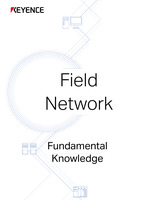SERCOS III
This section explains SERCOS III.
Overview
SERCOS III is an open network that uses Ethernet. It is managed by a German organization, Sercos International (SI). With highly efficient communication achieved by effectively using the communication band, synchronous timing jitter among slaves is less than 1 μs. High synchronization performance is guaranteed based on hardware, which allows this network to be used for highly accurate control such as motion control.
Wiring Method and Communication Protocol
Wiring method
This network environment can be built at relatively low prices because its structure is based on inexpensive general-purpose Ethernet. Up to 511 slaves can be connected, with support for line and ring topologies. If a cable is disconnected in a ring topology network, communication is reestablished using the other route immediately after the disconnection. The time required for reestablishment is guaranteed to be 25 μs or less, which means that communication can continue with loss of data within a single control cycle at most.

When a disconnection is detected in a ring network, communication can be performed using the other route, preventing communication outages caused by the disconnection.
Communication protocol
SERCOS III transmits data using the on-the-fly method in which areas used by each node are allocated in a packet. When the packet passes through one node, its information is added to these areas and then the packet is sent to the next node. The number of packets transmitted in a network is small, which allows for efficient communication.

This network also supports communication between slaves without passing through the master. As in communication between the master and a slave, real-time communication can be performed between slaves.
Characteristics
SERCOS III has two communication channels: the real-time channel which performs punctual data transmission, and the UC channel which transmits data that require punctuality.
Real-time channel
In a SERCOS III network, when data is transmitted between the master and a slave, there are two data areas in the packet: one is for data from the master to the slave and the other one is for data from the slave to the master. Information on each slave is stored in the packet to share data. Therefore, information on all slaves can be shared within a cycle.
(Reference) Synchronization among slaves
SERCOS III can use a ring structure for the communication path. Delays in the communication path can be calculated by sampling the time at which a packet passes through each slave. Thus, the start timing among slaves can be synchronized with jitter of 1 μs or less.
UC channel
There is an area in packets, called the UC channel, which can be used freely. This area can be used to share Ethernet information or to share information between slaves.
Related Networks
SERCOS II
This is a ring topology network that uses optical fiber cables, allowing for communication at a transmission speed of 16 Mbps.
- Company, product, and network names mentioned on this page are either trademarks or registered trademarks of their respective companies.
- Note that some information, such as applicable standards and specifications, may have changed since this page was published.
November 2015





